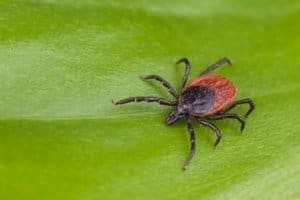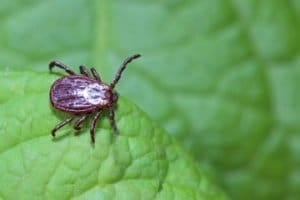Western blacklegged tick (Ixodes pacificus)

The Western blacklegged tick (Ixodes pacificus) is common in a variety of wooded habitats in Jackson County, particularly at mid to high elevations. Adult Western blacklegged ticks are very small, even relative to many other tick species. In the nymphal stage, these ticks will be even smaller, roughly the size of a pinhead. Females can be identified by the reddish body coloration and dark scutum, or “shoulders”. Males are smaller than females and appear nearly solid black. Both sexes have narrow mouthparts and very dark legs. Adults are most active in late winter and spring while immature stages (nymphs) are more active during spring and summer. Western blacklegged ticks are “3 host ticks”, meaning they use 3 different hosts during their lifecycle. Larvae and nymphs primarily feed on lizards and small rodents while adults prefer larger mammals like deer, squirrels, and raccoons. Both nymphs and adults will bite humans. This species is a known vector of Lyme disease and tick-borne relapsing fever.
Western dog tick (Dermacentor similis)

Western dog ticks are very common in Jackson County. They are associated most often with forest edges and open, grassy habitats with little or no tree cover. They are often found in urban and suburban areas as well. Dog ticks are relatively large ticks. Females have a brownish body with a white scutum, or shoulder area, while males have an all-over brown and white, marbled color pattern. Both sexes have short, stubby mouthparts. Dog tick larvae and nymphs feed on small mammals like mice and voles. Adults prefer medium-sized hosts like raccoons, coyotes, and domestic dogs and cats. This species can transmit tularemia, ehrlichiosis, and Rocky Mountain Spotted Fever.
Need a tick identified? Jackson County residents can e-mail a photo to office@jcvcd.gov or bring specimens to our district office where our staff will provide an identification for you!
